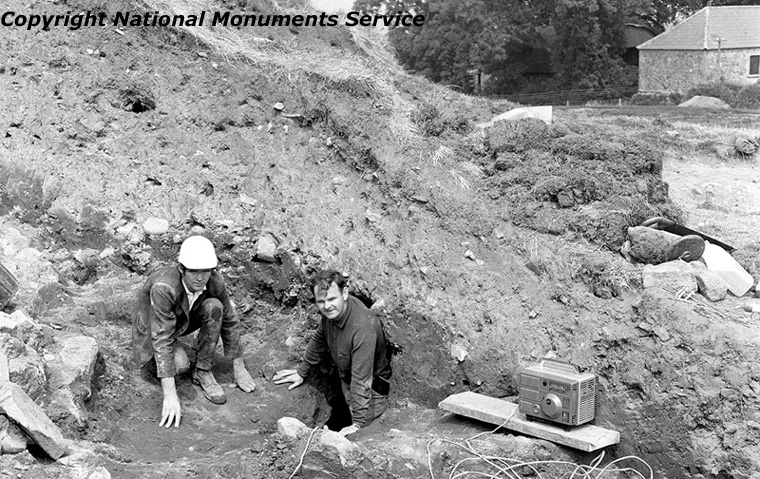Wonders of Knowth go on exhibition in Dublin

John Rock and George Eogan at the opening to the passage of the Eastern tomb at Knowth in August 1969
An exhibition of decorated and carved stones, brooches and necklets, pottery and other finds from the massive excavation of the Neolithic burial site at Knowth, Co. Meath, will be opened at the arts block of University College Dublin this evening. Knowth, which has been excavated for 22 years by Professor George Eogan of UCD, has turned out to be one of the richest sites of its kind in Europe, a cornucopias of archaeological detail and historical record, ranging from the third millennium BC to the last century. The site now excavated is a highly complex area covering several acres in the valley of the river Boyne near Navan.
Knowth has added significantly to the store of antiquities not just of Ireland but of Europe. It has provided the greatest number of decorated stones of any European passage tomb site up to 250. this exceeds the number of stones in France and is nearly twice the number found on the Iberian peninsula.
Largest in Europe
During excavations it was found that the Neolithic mound consists of two enormous chamber, the largest of their kind in Europe. There is a passage tomb cemetery, comprised of 20 individual chambers, grouped around the large mound. Not alone does this discovery throw new light on the burial rituals of the first settlers here, but it tells a great deal about the engineering, architectural and intellectual capacity of Neolithic.After the Neolithic period, Knowth again became important with the arrival of the Beaker people at the beginning of the Bronze Age (around 2,000 BC). Then for many centuries, until the coming of the late Iron Age (the early centuries AD), there appears to have been little activity on the site. The sophistication of the society of this third wave of inhabitants is evident from the items uncovered from graves in recent years.
King's Residence
A huge expansion in the settlement took place in the 8th century AD, which consisted then of a small village of about 12 houses, then souterrains and areas for industrial activity like bronze and iron working. This settlement, which was virtually self-sufficient, was for a time the residence of the kings of northern Brega.After the Norman settlement of the 13th and 14th centuries, which saw further structural additions to the summit of the large mound and the introduction of glazed, wheel made pottery, Knowth ceased to be of importance. It became largely neglected and deserted until excavations began in 1962. The exhibition will be opened at Belfield this evening by Dr. T.K. Whitaker, and will be on view to the public until May 12 from 1p.m. to 7 p.m. Monday to Friday, and 1p.m. to 5p.m. on Saturday.
Boyne Valley Private Day Tour
 Immerse yourself in the rich heritage and culture of the Boyne Valley with our full-day private tours.
Visit Newgrange World Heritage site, explore the Hill of Slane, where Saint Patrick famously lit the Paschal fire.
Discover the Hill of Tara, the ancient seat of power for the High Kings of Ireland.
Book Now
Immerse yourself in the rich heritage and culture of the Boyne Valley with our full-day private tours.
Visit Newgrange World Heritage site, explore the Hill of Slane, where Saint Patrick famously lit the Paschal fire.
Discover the Hill of Tara, the ancient seat of power for the High Kings of Ireland.
Book Now
Home
| Visitor Centre
| Tours
| Winter Solstice
| Solstice Lottery
| Images
| Local Area
| News
| Knowth
| Dowth
| Articles
| Art
| Books
| Directions
| Accommodation
| Contact

